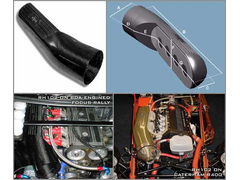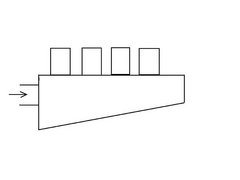pathfinder
|
| posted on 27/11/06 at 10:39 PM |

|
|
BEC Airbox design
A few people have asked me for air boxes recently so I’m doing a bit of research before putting pen to paper. It appears that most people want to
reduce induction noise and avoid chopping a big hole in there bonnet so I have a few questions for you:
• what clearance do you have between inlet trumpets and bonnet?
(please state engine and model/ manufacturer of car)
• What type of filter is most desirable: Cone, panel, sock or cylindrical element? foam or cotton material?
• The picture below shows the sort of airbox arrangement that I’m thinking of. I would either:
A. Have a cone filter mounted in the nose cone and run some ducting to the airbox inlet.
B. Have a panel filter mounted over the airbox inlet and ducting to the front of the car.
C. Have a cone filter mounted directly onto the airbox.
Witch option do people prefer?
Has anyone got the dimensions of a pipercross (or similar) flat pancake filter, am I correct in assuming that you have to cut your own holes in the
aluminium bottom plate for the inlet trumpets????
If anyone has any photos or other ideas that they would like to contribute please let me know.
Cheers chaps

 
Rescued attachment airbox.JPG
|
|
|
|
|
mark chandler
|
| posted on 27/11/06 at 10:57 PM |

|
|
A) floats my boat, decent housing to grab all the pipes then lead off to a standard size tube (say 3" . .
You can then just plant the filter on this (a cheap one from Fleabay), and get some ducting at a later stage and pull to the front.
Keep it under a flat bonnet, easy to make and no unsightly bulges.
so I need to change the angle of the carbs or inject.
Regards Mark
|
|
|
mark chandler
|
| posted on 27/11/06 at 10:57 PM |

|
|
A) floats my boat, decent housing to grab all the pipes then lead off to a standard size tube (say 3" . .
You can then just plant the filter on this (a cheap one from Fleabay), and get some ducting at a later stage and pull to the front.
Keep it under a flat bonnet, easy to make and no unsightly bulges.
I need to change the angle of the carbs or inject to stop the bonnet stifling the carbs
Regards Mark
[Edited on 27/11/06 by mark chandler]
|
|
|
jambojeef
|
| posted on 27/11/06 at 11:40 PM |

|
|
Carbon airboxes just look so nice....
iirc isnt it preferable with airboxes which have inlets off to one side of the row of carbs / tb's to reduce the chamber cross-section the
further away from the inlet?
A bit like this badly drawn picture...
Theres a ratio used in A Graham Bells performance tuning to work out how steep the taper should be - iirc it evens out the flow through each throttle
but it could be only for forced induction engines - it might be worth checking it out though...?
Cheers
Geoff
[Edited on 27/11/06 by jambojeef]
 
Rescued attachment untitled.JPG
|
|
|
chockymonster
|
| posted on 27/11/06 at 11:45 PM |

|
|
Pipercross flat panel is
L 435mm W 190mm EH 55mm IH 40mm that's on an R1
I don't have a lot, if any clearance under my bonnet and scoop with that filter.
If I could get an airbox of those dimensions then I'd be happy
Dimensions of the PX600 airbox are
http://www.pipercross.net/images/600_series_airbox_dimensions.gif
[Edited on 27/11/06 by chockymonster]
PLEASE NOTE - Responses on Forum Threads may contain Sarcasm and may not be suitable for the hard of Thinking.
|
|
|
gingerprince
|
| posted on 28/11/06 at 12:12 AM |

|
|
Problem is that for people who already have foam filter with no box who want to quieten induction - a dynojet kit will (should) have been fitted, and
therefore depending on the model of the carbs air holes will have been enlarged or filled to compensate for the change in airflow. IIRC you
can't go back to an airbox (of any shape) once you've jetted carbs because of this.
May be a different story for TBs though?
|
|
|
oddsaabs
|
| posted on 28/11/06 at 12:21 AM |

|
|
Pathfinder,
I think Geoff is on the right track. The plenum (that's actually a word) should taper from the inlet to the farthest carb/throttle body. There
is also a simple rule of thumb that says the volume of the plenum should be 40 - 60% of the total volume size. A 1 liter motor should have a 1/2
liter plenum. I'd like to see something around the size of 700cc to 750cc as my motor is slightly larger than most.
The Pipercross foam unit has a base measuring 435mm by 190mm and various heights from 90mm to 150mm. see
http://www.pipercross.net/competition_carb_px600.asp Normally we would just cut the base to fit our throttle bodies/carbs, and that would be fine
with me if that's what you came up with as well.
I'm not too concerned about the height. Clearance isn't too big of a concern for me. Some of the other builders will have much more to
say on that topic.
As far as the opening goes, I would vote for a 3" opening at the end to fit either a cone or intake from the intercooler (got to think about the
future here). Which reminds me, what ever it's made of, it should be sturdy enough to handle some boot pressure without leaking.
If you do decide to produce something along these lines please keep my contact as I'd be first in line.
Thanks,
Jonathan
|
|
|
Hellfire
|
| posted on 28/11/06 at 08:02 AM |

|
|
oddsaabs - 40% to 60% of the engine capacity is that how I read it? 
That may apply to car engines but certainly not for bike engines. Almost ALL bike engine air boxes are at least 4 litres against a 1 litre blade for
instance. Our new airbox is calculated as optimum being 11 litres. As this is posted in a BEC forum, I'm afraid those figures are deffo
incorrect.
How strange?
Steve
[Edited on 28-11-06 by Hellfire]

|
|
|
tks
|
| posted on 28/11/06 at 10:45 AM |

|
|
mhhh
wouldn´t the BHP / Litre be the figure to watch for??
it says everything about air consumed (BHP) and whats taken out the box per rev!!
also high revs will consume more..
you fight against a constant and thats the time needed for the air to get in the box and fill it again....
Tks
[Edited on 28/11/06 by tks]
The above comments are always meant to be from the above persons perspective.
|
|
|
clutch_kick
|
| posted on 28/11/06 at 12:06 PM |

|
|
I kind of like the foam sticking out of the bonnet.  Makes the car look proper! Makes the car look proper!
|
|
|
oddsaabs
|
| posted on 28/11/06 at 01:29 PM |

|
|
That may apply to car engines but certainly not for bike engines. Almost ALL bike engine air boxes are at least 4 liters against a 1 liter blade for
instance. Our new airbox is calculated as optimum being 11 litres. As this is posted in a BEC forum, I'm afraid those figures are deffo
incorrect.
Steve,
Your right of course, that fraction comes from the world of auto engine performance. It never occurred to me that bike engines power plants would
need SO MUCH more air. Do bike engines require so much more air because of the higher rpm's and resulting increased air consumption?
How did you calculate the required airbox volume? Is there a formula for the airbox volume that looks at displacement/rpm’s and air mass flow rate,
similar to the way we calculate for the proper injectors?
I'll admit I'm on a learning curve when it comes to BEC's. Try to learn something new every day my Momma says....
J
|
|
|
ettore bugatti
|
| posted on 28/11/06 at 08:04 PM |

|
|
Search on Google on Helmholtz manifolds.
I guess for optimal results, you have to fine tune the volume of the plenum and runners (or dimensions) on a dyno.
Honda used on the B18C (Civic/ Integra Type-R engine 1800cc) a manifold with a volume of circa 1,1 litre.
I guess this difference between BE's and CE's manifolds volumes is in the that Bikes use ITB and cars mostly a single TB.
[Edited on 28/11/06 by ettore bugatti]
|
|
|
jambojeef
|
| posted on 29/11/06 at 05:03 PM |

|
|
I think this might have been mentioned previously - but the volumetric efficiency of bike engines is usually significantly higher than car engines and
so the actual flow into the inlet tracts is much higher.
In line with what others have said I was aiming for a plenum of 1,5 litres but have ended up with one closer to 2,5 owing to packaging.
Being forced induction it may differ again and without my A Graham Bell tuning book in front of me I cant qquite remember what is reccommended but it
has a good section in it iirc
Geoff
|
|
|
ettore bugatti
|
| posted on 4/12/06 at 06:55 PM |

|
|
I found some links about this subject on other forums:
http://www.petrolheads.co.uk/gassing/topic.asp?t=246780&f=66&h=0
http://72.14.221.104/search?q=cache:UPaBCk-KZNgJ:www.190revolution.net/~revol/forum/viewtopic.php?p=110187&sid=a03b228633219af292a1edbc0158ab31+ai
rbox+plenum+volume&hl=nl&gl=nl&ct=clnk&cd=13
|
|
|













